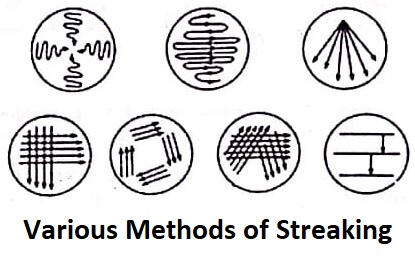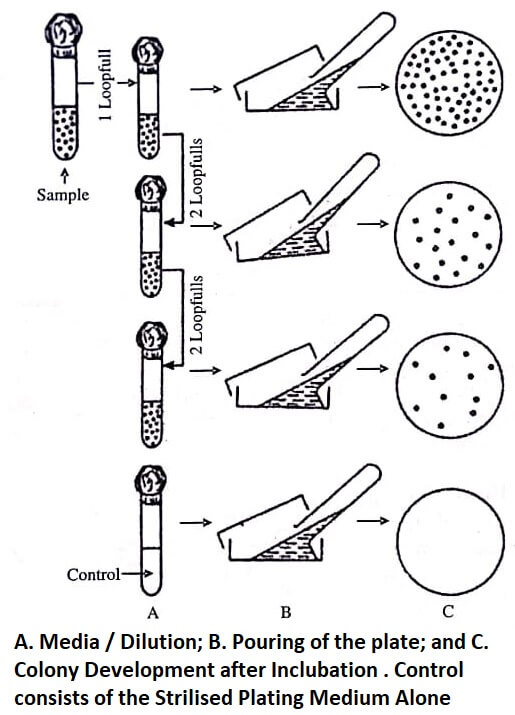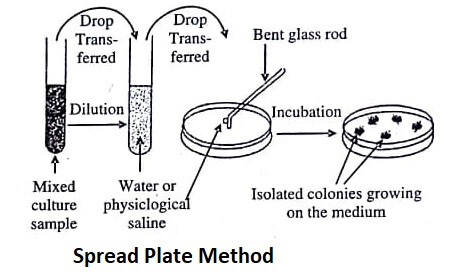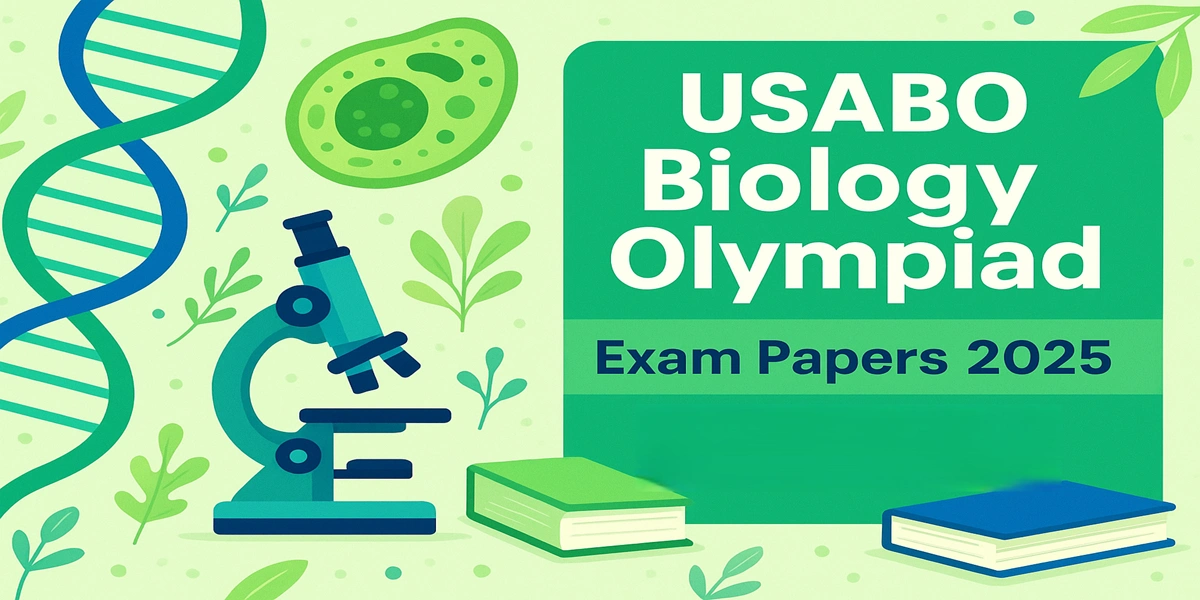Culture is a procedure during which microorganisms are cultivated in a medium; if a culture has the population of a single type of microorganism; it is known as a pure culture.
Usually, isolation and growth of pure cultures of single-celled microbes carried under aseptic conditions needs sterilised instruments in addition to filtered and still air.
The growth of microbes on the surface of a petri dish usually provides their isolated colonies. An appropriate growth medium, commonly gelled with agar is present in a petri dish (or plate) to facilitate the growth of desired microbe.
Manipulation of the inoculum (initial sample) with an inoculation loop or needle is done, so that the cells are diluted and allowed to spread on the surface of the plate to achieve the isolation of a pure culture. The objective of this procedure is to ultimately obtain some areas on the petri dish that have isolated single cells. Incubation of the culture under suitable environmental settings is carried out till the cells grow and bacterial colonies become visible.
Colonies that have been isolated properly have maximum chances of being cultivated from single cells, and therefore they are regarded as pure cultures. A pure culture can also be prepared by high dilution from a liquid culture into a liquid medium. At sufficient dilution only a fraction of the inoculated culture tubes grow, and there are high chances that these cultures are originated from a single cell.
Streak-Plate Technique
In this method, a fraction of the mixed culture is placed on the surface of a medium containing agar and is streaked across the surface using a transfer loop. As a result of this manipulation, the bacterium present on the surface of agar ‘thins out’, facilitating the separation of some individual bacteria from each other.
Different methods of streaking a culture plate to obtain isolated colonies are illustrated in figure. It is recommended that second plate should be streaked using the same loop/needle without re-inoculation. These plates are then incubated for allowing the colonial growth.

This method relies on the principle that streaking establishes a dilution gradient across the face of the petri plate as bacterial cells deposit on the agar surface. Due to this dilution gradient, confluent growth does not take place on the part of medium where bacterial cells are deposited.
It is assumed that each colony is the progeny of a single microbial cell, thus each colony represents a clone of pure culture. These isolated colonies are separated with a sterile inoculating loop and re-streaked on a fresh medium to maintain purity.
Advantages
- Numerous bacterial cells spread over the medium surface.
- Individual bacterial cells deposit at some distances from each other.
- Distinct colonies are formed, which do not touch each other.
- Cloning of single bacteria of pure culture is possible.
Pour-Plate Technique
In this method, diluted samples mixed with melted agar medium are plated (figure). This method relies on the principle that the inoculum is diluted in successive tubes containing liquefied agar medium for thorough distribution of bacterial cells in the medium.

In pour-plate method, the mixed bacterial culture is diluted directly in test tubes containing melted agar medium maintained at 42−45°C (agar solidifies below 42°C ). The bacteria and the melted medium in tubes are mixed properly.
The contents of each tube are poured in separate petri plates, solidified, and then incubated. On development of bacterial colonies, it is observed that isolated colonies develop within the agar medium (sub-surface colonies) as well as on the medium (surface colonies). These isolated colonies are picked up by inoculation loop and streaked on another petri plate to maintain purity.
The pour plate method has following disadvantages :
- The sub-surface colonies are dug out of the agar medium, thus disturbing the other colonies.
- The isolated bacteria should resist temporary exposure to 42−45°C temperature of the liquid agar medium, thus this method is not preferred for isolating psychrophilic microorganisms.
However, the pour-plate method apart from being used for isolating pure cultures is also used for estimating the number of bacterial cells viable in a culture.
Spread-Plate Method
In this method (figure), unlike the pour-plate technique the mixed culture or microorganism is not diluted in the melted agar medium; but diluted in a series of test tubes containing sterile liquid (water or physiological saline).

A drop of diluted liquid from each tube is placed on the centre of an agar plate and spread uniformly on the surface using a sterilised bent glass rod. Thereafter the medium is incubated.
After the development of bacterial colonies on the agar plates, it is observed that in some plates well-isolated colonies have grown. This is because when the drop of diluted liquid is spread on the agar plate, individual microorganisms separate out.
The isolated colonies are picked up and transferred on another fresh medium to maintain purity. In this method, only surface colonies develop and the microorganisms are not required to withstand the temperature of the melted agar medium.
Serial Dilution Method
This method is used for obtaining pure cultures of those microorganisms that grow only in liquid media and are still to be cultivated on solid media.
A series of dilutions aids in isolating a pure form of microorganism, from a mixed culture. The inoculum is undergone serial dilution in a sterile liquid medium, and a large number of tubes containing sterile liquid medium are inoculated with aliquots of each successive dilution.
Serial dilution aims to inoculate a series of tubes containing such dilute microbial suspension that some tubes show growth of only one individual microbe.
Let us assume a culture of 10ml liquid medium containing 1,000 microorganisms (figure), i.e., 100 microorganisms/ml of the liquid medium.
If 1ml (100 microorganisms) of this medium is removed and added to 9ml of fresh sterile liquid medium, 10ml medium with 100 microorganisms (i.e., 10 microorganism/ml) is obtained. If again 1ml (10 microorganisms) of this suspension is mixed with 9ml of another fresh sterile liquid medium, 10ml medium with 10 microorganisms (1 microorganism/ml) is obtained.
If this tube shows microbial growth, it is the result of introducing a single microorganism in the medium; and it is the pure culture of that microorganism.
| Read More Topics |
| Morphological classification of bacteria |
| Cytoplasm and cytoplasmic inclusions |
| Cultivation of bacteria (Aerobes and Anaerobes) |
| Gram positive and gram negative cell wall |





